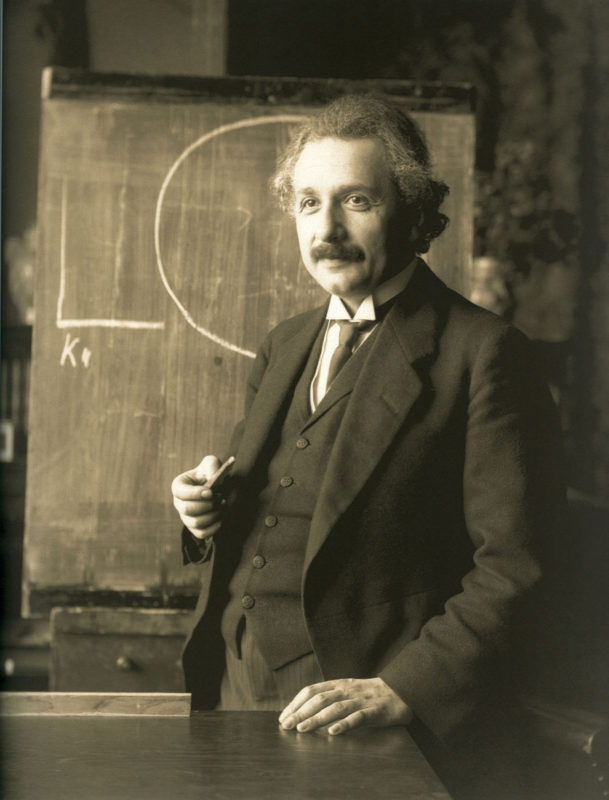February 26, 2017 8:00 pm
20 Immigrants & Refugee Scientists Who Made America Greater (Part 1)
How opening our borders fostered a new age of American scientific leadership and prosperity
Today’s guest blog post is by StarTalk intern Kirk Long. Kirk is majoring in physics while minoring in mathematics and piano at Idaho State University.
It’s easy to forget that the United States was not always the superpower it was, and even easier to forget the people who helped lift our country up to the stature it holds today. We were largely an isolationist country up until the first World War, but with a new world climate and the technology to travel great distances safer and easier than ever before, we began attracting talent from around the world. Leading up to World War II we continued to attract disenfranchised scientists — including Albert Einstein, and as a result of opening our borders the Allies were able to outpace the Axis powers, and someday we would build our rockets to the moon based on the work of those immigrant scientists. Despite making up just 13% of the United States population, foreign-born scientists have brought home more than a third of our nation’s Nobel Prizes in STEM fields (117 out of 342; click for a list of every Nobel Prize-winner not born in the United States but who won their Nobel Prize for work done in the United States).
The US is seen as a technological innovator throughout the world, but this would not have been possible without immigration. In the spirit of remembering those who have come before us and paved the way for our successes, I’ve created a list of some of science’s most important figures who also just happened to be immigrants or refugees.

Albert Einstein during a lecture in Vienna in 1921, by Ferdinand Schmutzer. Credit: Public Domain, via Wikimedia Commons.
Albert Einstein — Nobel Prize-winning physicist
Albert Einstein, perhaps the most famous scientist of all time, was also a refugee. Born in Germany in 1879, he was fortunate enough to be abroad when Adolf Hitler rose to power in 1933, and the United States was fortunate he eventually chose to settle here. Being Jewish, the Nazis confiscated Einstein’s belongings and property, and so he renounced his German citizenship and began the path to becoming an American citizen — he officially gained citizenship status in 1940. Einstein strongly advocated for the US, Britain, and the other allied powers to take in as many Jewish refugee scientists as they could, resulting in thousands of lives being saved. Winston Churchill recognized the importance of the scientists, saying that the Axis powers were idiots to expel these brilliant minds from their countries, and that scientists like Einstein would give the Allies the technological advantage they would need to later win the war. Although Einstein is best known for his general and special theories of relativity and the world’s most famous equation, E=MC2, he published more than 300 papers on a variety of topics ranging from particle theory to the discovery of the photoelectric effect, a foundational work in the evolution of quantum theory.
Nikola Tesla — Expansion of AC current
Nikola Tesla is perhaps the most famous archetypical “mad scientist” figure in modern society. He was truly dedicated to scientific exploration — he used all of the profits he made from his inventions to fund his future projects, and eventually, despite his fame, and success, he died broke in a New York City hotel room. He had emigrated from Serbia at the end of the 19th century, where he had studied advanced physics and mathematics, impressing his teachers by doing integral calculus in his head (and being accused of cheating for it). Tesla is most famous for his invention of the alternating current induction motor, which enabled the rapid adoption of electricity across the United States and the development of the power grid we all take for granted today. Tesla later experimented with a variety of other topics, including wireless communication — he built the first remote controlled boat — and x-ray imaging. Tesla was a scientist, inventor, and innovator well ahead of his time who dared to dream and invent the world he wanted, and today his legacy lives on every time we turn on our lights.
Sergey Brin — Cofounder of Google
Sergey Brin was born in 1973 (during the midst of the Cold War) in Moscow of what was then the Soviet Union, and when he was just 5 years old his family fled to the United States after facing significant Jewish persecution. Brin would go on to get his Bachelor’s degree from the University of Maryland, where he studied mathematics and computer science. He continued his studies in computer science at Stanford, but was interrupted when he and his roommate (Larry Page) stumbled upon an invention that would change the world — the search engine. Page and Brin suspended their graduate studies at Stanford to pursue Google — named for the mathematical term “googol” in honor of the vast amount of information stored in the internet — and the rest is history. When Google’s stock went public in 2004, Brin and Page both became instant billionaires, and to this day Brin is one of the most successful and influential entrepreneurial scientists in the world. Brin and Google have expanded beyond the realm of just search engines — the parent company they created for Google and their other projects (Alphabet) owns companies pursuing ventures as bold as attempting to cure death.
Elon Musk — Founder of SpaceX and Tesla Motors, cofounder of PayPal
Elon Musk was born in South Africa in 1971, but came to the United States to study at the University of Pennsylvania, where he got bachelor’s degrees in both economics and physics. He continued on to Stanford with the intent of getting a Ph.D. in energy physics, but the internet exploded during his time there and he dropped out to pursue what would become PayPal. He made his first fortune when PayPal was bought by Ebay, and used that money to start SpaceX and then Tesla. Although both got off to rocky starts, SpaceX now has contracts with NASA to resupply the International Space Station and has even landed rocket boosters after use on pads both at sea and on land, and Tesla has become a successful and well-reviewed luxury car brand. Musk is often compared to a real-life Tony Stark, and has just as big of aspirations — SpaceX intends to land on and colonize Mars.
Mario Molina — Nobel Prize-winning chemist
Mario Molina was born in Mexico in 1943, but later in life he would study in both Germany and the United States, and would eventually win a Nobel Prize for his work here in the U.S. Molina studied the links between man-made compounds in the atmosphere and the weakening of the ozone layer, as well as their relation to climate change, and his work helped us identify ways we can improve and better treat our atmosphere.
Subrahmanyan Chandrasekhar — Nobel Prize-winning physicist
Subrahmanyan Chandresekhar was a pioneering Indian-American astrophysicist most noted for his work on stellar evolution and black holes. His intense mathematical descriptions of later stellar evolution have yielded some of best theoretical models for stellar death and the creation of black holes. The Chandrasekhar limit — the maximum mass to which a stable white dwarf star can grow before collapsing/exploding — is named for him, and is an incredibly useful “standard candle” tool that astronomers use to measure distances more accurately. Type 1a supernovae are the results of white dwarves that reach the Chandrasekhar limit (usually because they are part of multiple star systems and they accrete gas from stellar companions) and because of Chandrasekhar’s work we know the mass of these objects when they explode, meaning that the only variable involved in how bright they appear to us is how distant they are. This simple and elegant idea allows us to use these explosions as lighthouses of sorts, allowing astronomers to more accurately figure out the distances of things in space. The Chandra X-Ray Observatory, which has been used to make many exciting black hole discoveries, is named in honor of Chandrasekhar.
Andrew Grove — Helped found Intel
Andy Grove was a Hungarian born scientist who, after fleeing during the Hungarian revolution of 1957, got his Ph.D. from Berkeley in chemical engineering. In 1968 he helped start Intel and became its first director of engineering, where his scientific prowess and technical computer knowledge helped get the company off the ground. Grove eventually became CEO, and he made the difficult decision to switch Intel’s business focus from computer memory to microprocessors, but in doing so made one of the most successful business and technological decisions ever made. Under his tenure, Grove oversaw a 4,500% increase in Intel’s market capitalization, which made it the world’s 7th largest company employing more than 60,000 people.
Enrico Fermi — Nobel Prize-winning physicist
Enrico Fermi was an Italian born physicist who fled Italy in the late 1930’s to escape racial laws that affected his Jewish wife, Laura Capon. Shortly after arriving in the United States he was sent to work on the Manhattan Project, where he was instrumental in both the practical development and theory behind harnessing nuclear fission. He is credited for producing the first nuclear reactor, and is often called the architect of the nuclear bomb. Fermi is somewhat unique among physicists for excelling in both theoretical and experimental fields, and throughout his life he made significant contributions to nuclear, quantum, particle, and statistical physics.
Carl Djerassi — Father of “the pill”
Carl Djerassi and his mother were forced to flee Nazi Germany when he was just 16 years old. When they arrived in New York broke, tired, and confused, their last $20 was swindled out of them by a shady cab driver. In desperation, Djerassi wrote of his plight to Eleanor Roosevelt, and she quickly found him a college scholarship. He became a chemist, and was an integral part of the team that first synthesized a progestin called norethindrone, which would become the key ingredient of the pill. With the success of oral contraceptives in America, Djerassi attained great wealth and would become a professor, writer, art collector, and advocate for reproductive rights. He died on January 30, 2015 at the age of 91 in his home in San Francisco.
Amar Bose — Engineer and founder of Bose
Everyone wants Bose speakers, and the company behind that amazing sound has an American immigrant story that many don’t know. Amar Bose was born to a recent immigrant family in Pennsylvania of 1929. His father was a Bengali Hindu and Indian freedom revolutionary who had fled from persecution by the British police to the U.S. shortly before Bose was born. Bose went on to get a Ph.D. in electrical engineering from MIT. While he was working as a professor, he became dissatisfied with a high-end set of speakers he had purchased and started tinkering. His research into acoustics and speaker technology would lead to the first Bose speakers, renowned today for their ability to accurately recreate sound as it was meant to be heard. Today Bose employs almost 12,000 people, has contracts with both NASA and the military, is highly sought after in the commercial market, and brought in more than $3 billion worth of revenue in 2015.
In reality there’s almost no limit to the positive impact that refugees and immigrants have made to the American success story — after all, this country was settled by immigrants from somewhere at one point or another. Although this post reflects some great scientists, while writing it we decided it wasn’t enough. Come back next week for another 10 immigrant and refugee scientists we think changed the world for the better, and sound off in the comments about why you’re thankful for the advancements in science your favorite refugee or immigrant helped create.
Until then, “Let’s Make America Smart Again.” #LMASA
Get the most out of StarTalk!
Ad-Free Audio Downloads
Priority Cosmic Queries
Patreon Exclusive AMAs
Signed Books from Neil
Live Streams with Neil
Learn the Meaning of Life
...and much more

 Become a Patron
Become a Patron

